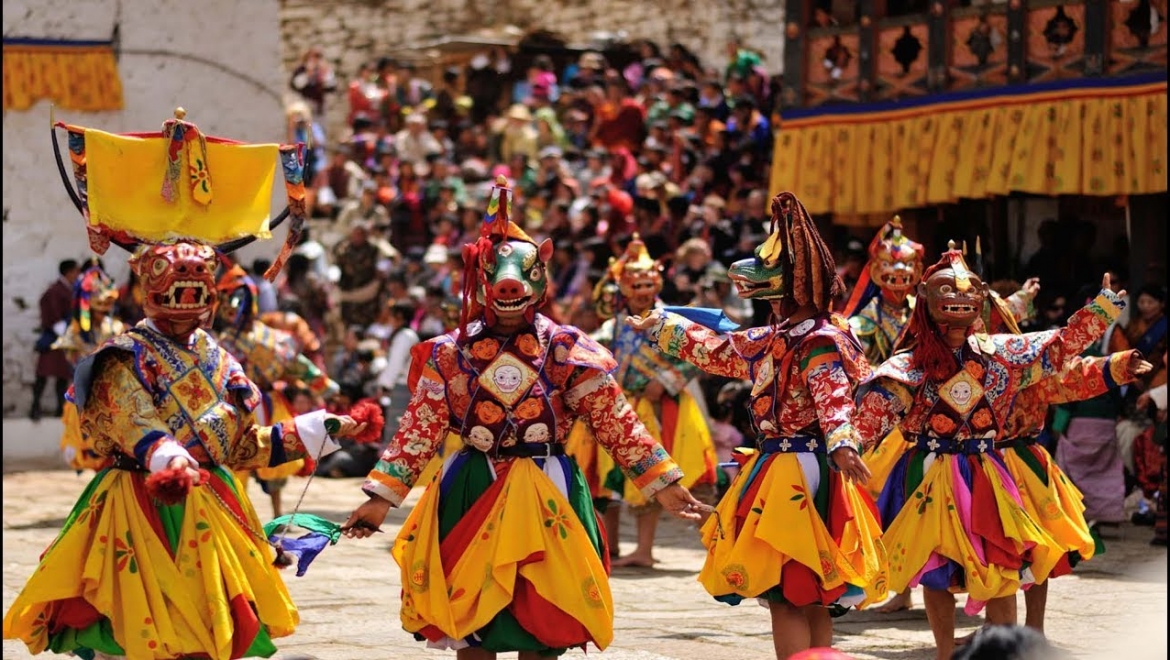Nestled in the peaks of the Himalayas, the small country of Bhutan is often overlooked in international maps – after all, it is smaller than even some Indian states! However, it’s size is in no way an indication of its culture and heritage, for Bhutan has a rich history that has been carefully preserved over the centuries, and today, it stands as a pillar of uniqueness in an increasingly globalizing and homogenizing world.
In the tongue of the Bhutanese people, their country is called Druk Yul, or the land of the thunder dragon. The very frequent thunderstorms that lash down on the region are the source of this legend, and the famous dragon features on the flag of Bhutan as well.
In its long history (the country’s existence is traced back to 2000 BCE in inhabitation, and the 7th century is noted for the emergence of civilization and kingdoms) the country has never been colonized, despite being wedged between the powerful Indian and Chinese empires. It’s location in the impervious mountains and focus on local affairs as been the reason for its enduring independence. As a result of this, Bhutan’s culture remains uniquely pure, though heavily influenced by the Indian subcontinental forces. The rulers of Bhutan have tried their best to maintain their age old culture. Television was only adopted in 1999, and the channels provided are restricted, the Butanese people are expected (and required) to wear the national dress while in public, and restrictions exist for those who marry non-citizens of Bhutan. Also, the country is not open to free travel, and one has to book an official tour with the country’s government in order to visit it.
This is perhaps the most defining feature of the culture of Bhutan, the fact that there is such a strong emphasis on maintaining it, even in the face of increasing globalization and modernization pressures. While some may feel it arbitrary, records show that the Bhutanese people actually believe in, and do enjoy following, the standards, expectations, and social norms set out for them. The country’s happiness index is a testament to this fact.
The earliest rulers of Bhutan, dating back to the 7th century, brought with them the ideas of Buddhism, and the culture of country is centered around Buddhism, which is the national religion of the country. Hence, Buddhist teachings form an important core of childhood education, guide adult life, and influence everyday prayers and practices. Monasteries, prayer flags and other icons of religion dominate the landscape of Bhutan. When children are born, they are named not by their families, but by the lama, the local Buddhist priest.
Religion is also seeped into the many festivals that Bhutan celebrates. The calendar of the country is dotted with holidays, which often fall on days on seasonal or religious importance. The religious festival of Tshechu, held by the most important village of the district annually, is amongst the most important festival, and acts as a social gathering where people from distant places are able to come together and enjoy social and religious activities, such as dances and moral vignettes. Alongside these, numerous other Buddhist and Hindu holidays are celebrated, such as the birth anniversary of the Buddha, or the festivals of Holi and Diwali. Days of importance to the royal family, such as the King’s birthday and coronation anniversary, also invite festivities. Though Bhutan follows the Gregorian calendar, festival dates are decided according to the lunar calendar.
A typical feature of festivities in Bhutan is the song and dance that accompanies the days. Performed in public, they have important social and religious functions. Music is considered to be an important part of both life and religion, and monks often play instruments such as flutes and fiddles. Folk music is practiced widely, and requires training not just in singing, but also facial expressions, gestures and manners of conduct.
Music is seldom practiced alone – dances usually accompany the songs. The most famous amongst the dances is the Cham dance, where masked performers dance to music and depict important moral ideas or stories from the life of the saint Padmasambhava, the Buddhist master responsible with bringing the religion to the country. Considered as an offering to god and a form of mediation, the dance is a stellar highlight of the way religion, culture, and social life intersects in the country of Bhutan.
Though dance and music have been a historical part of Bhutan, cinema has not been – the industry emerged only in the late 1990s, and is heavily influenced by India’s Bollywood industry, with most movies being adaptations. Now, stories based on Buddhist oral narrations and supernatural beliefs are beginning to take cover, showing once again the preference for the preservation of the country’s culture.
Despite the gendered segregation of work where men are active in public life and women dominate the house, Bhutan is known for its gender-neutral approach to a number of matters. Matriliny is a common practice, with the women inheriting her parents’ wealth and house. Men are expected to make their own way into the world. Weddings are simple affairs, but birth and death are important, with numerous rituals associated with both. This again highlights the Buddhist influence on culture, as the religion believes in the cycle of rebirth.
The cuisine of the country is as rich as any other nation of the Indian subcontinent, and ema datshi, a dish made from chilli peppers and cheese, is very popular amongst the people. The food is usually simple but with lots of variety and flavour, and staples such as rice, pork, and lentils are common. Despite the advent of modern dining settings, many Bhutanese families prefer to sit on the wooden floor and eat together. Before eating, families place a small morsel on the floor in tribute to the local deities and spirits that they believe in.
The literature and artwork of Bhutan is again religion-centric. The tradition has been of oral narratives, passed down the generations, rather than written work. However, there is a notable absence of a contemporary literary culture in the country – unlike other nations of the subcontinent, Bhutan has produced near to none modern works of prose, poetry or nonfiction.
The artwork in Bhutan however, continues to be rich and vibrant. Ancient practices continue to be reflected in modern artwork, often done on monastery walls, rocks, and other mediums. Embroidered cloth and statues are also common, and most artwork depicts scenes of Buddhism or the country’s history.
Despite increasing international curiosity and the potential economic gain, the government of Bhutan has elected to keep tourism in the country restricted, to avoid external influence and damage to the country’s delicate environment and cultural heritage. Foreigners were allowed to visit the country only from 1974 onwards, and citizens of a privileged few nations, including India, Maldives, and Bangladesh, can move into the country without a visa. The police of the nation is that of ‘low volume, high impact’, which aims at controlling the number of tourists in the country both to protect the culture of the nation, and to ensure that the tourists who do visit are able to enjoy the country to the fullest.
The Taktsang Monastery is the most famous of the numerous tourist sites of Bhutan, and consists of a monastery perched on a hill, near the caves the legendary Padmasambhava meditated. Numerous other monasteries and wildlife parks are also common attractions. Hiking, nature photography, and the chance to explore a mysterious and unique cultures are other reasons why people have been increasingly looking towards Bhutan.
Bhutan remains a testament to the will of its people, who have not only maintained their independence in the many centuries since the country’s formation, but have also actively protected their history, culture and heritage, unbothered by the waves of international influences. In doing so, the country has become a beacon of happiness and uniqueness, defined by an identity and culture that is their of their own choosing, visible in the everyday workings of their lives.





Add Comment